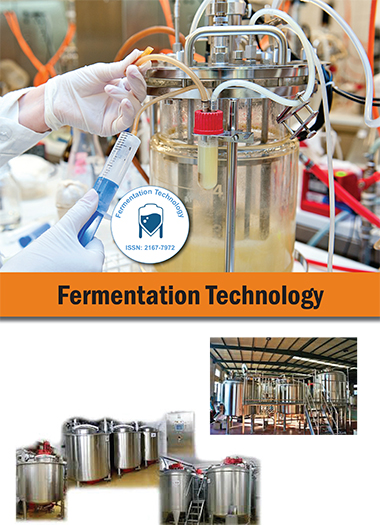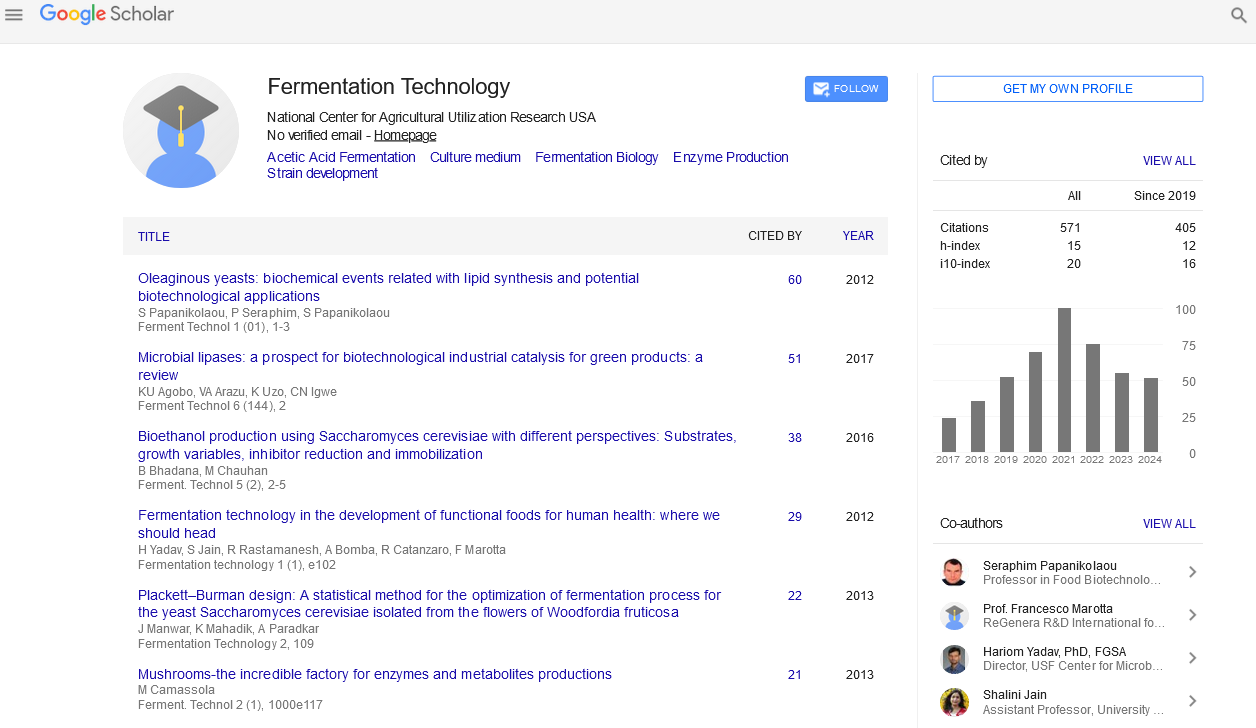Indexed In
- Open J Gate
- Genamics JournalSeek
- Access to Global Online Research in Agriculture (AGORA)
- RefSeek
- Hamdard University
- EBSCO A-Z
- OCLC- WorldCat
- Publons
Useful Links
Share This Page
Journal Flyer

Open Access Journals
- Agri and Aquaculture
- Biochemistry
- Bioinformatics & Systems Biology
- Business & Management
- Chemistry
- Clinical Sciences
- Engineering
- Food & Nutrition
- General Science
- Genetics & Molecular Biology
- Immunology & Microbiology
- Medical Sciences
- Neuroscience & Psychology
- Nursing & Health Care
- Pharmaceutical Sciences
Perspective - (2025) Volume 14, Issue 1
Comparative Study of Submerged and Solid-State Fermentation for the Production of Industrial Enzymes
Ryan Peter*Received: 26-Feb-2025, Manuscript No. FMT-25-29072; Editor assigned: 28-Feb-2025, Pre QC No. FMT-25-29072 (PQ); Reviewed: 13-Mar-2025, QC No. FMT-25-29072; Revised: 20-Mar-2025, Manuscript No. FMT-25-29072 (R); Published: 27-Mar-2025, DOI: 10.35248/2167-7972.25.14.182
Description
Industrial enzymes such as amylases, proteases, cellulases and lipases are widely used in sectors including food, textiles, pharmaceuticals, detergents and biofuels. Microbial fermentation remains the primary method for enzyme production, with two dominant approaches: Submerged Fermentation (SmF) and Solid-State Fermentation (SSF). Each technique has unique advantages and challenges and selecting the appropriate method depends on factors such as microbial strain, substrate type, product stability and downstream requirements.
Overview of fermentation systems
Submerged Fermentation (SmF): SmF involves the growth of microorganisms in a liquid nutrient medium with controlled parameters such as aeration, temperature and pH. It is the conventional method used in large-scale bioprocesses, especially for bacterial and yeast-based enzyme production.
Solid-State Fermentation (SSF): SSF utilizes solid substrates with minimal free water, supporting microbial growth primarily on the surface. It mimics natural microbial habitats and is especially suited for filamentous fungi and spore-forming bacteria.
Microbial strain suitability
SmF: Bacteria like Bacillus subtilis, yeasts such as Saccharomyces cerevisiae and some fungi are well-adapted to liquid environments. Their rapid growth and the ease of genetic manipulation make SmF attractive for industrial enzyme synthesis.
SSF: Filamentous fungi such as Aspergillus niger, Trichoderma reesei and Penicillium species are ideal for SSF due to their ability to colonize solid substrates and secrete large amounts of extracellular enzymes.
Substrate utilization and cost
SmF: Requires pre-processed substrates like glucose, starch hydrolysates, or defined media, increasing raw material costs. However, SmF allows for precise control and monitoring of nutrients, which can optimize yield and product quality.
SSF: Supports the use of agro-industrial waste such as wheat bran, rice husk and bagasse, offering a cost-effective alternative. These substrates provide both carbon and support for microbial growth, reducing the need for additional nutrients.
Process control and scale-up
SmF: Well-established control systems allow real-time monitoring of pH, oxygen, temperature and biomass. Large-scale reactors such as stirred-tank or airlift fermenters enable consistent performance and easier scale-up.
SSF: Monitoring is more difficult due to limited instrumentation that works in semi-solid environments. Parameters like moisture content and oxygen diffusion are harder to control. Scale-up requires specialized bioreactor designs, such as tray fermenters or rotating drums, to manage heat and airflow distribution.
Enzyme yield and stability
SmF: Typically results in lower enzyme concentrations due to dilution in the liquid phase. Enzymes may also be more prone to degradation if not rapidly recovered. However, consistent aeration and mixing support uniform microbial activity.
SSF: Often yields higher enzyme concentrations, especially in fungal systems. Enzymes tend to be more stable due to lower water activity and reduced protease-mediated degradation. SSF may also produce enzymes with different glycosylation patterns or isoforms better suited for specific applications.
Energy and water requirements
SmF: Demands higher energy input for agitation, aeration and temperature control. Significant volumes of water are required for media preparation, sterilization and cleaning.
SSF: Operates at lower moisture levels, reducing water and energy consumption. The reduced liquid volume simplifies downstream processing and minimizes effluent treatment.
Downstream processing
SmF: Enzymes are already in solution, facilitating filtration, centrifugation and purification. However, dilute enzyme concentrations can increase the cost of concentration steps.
SSF: Requires extraction of enzymes from solid substrates using buffer systems. This step may be labor-intensive but can yield highly concentrated enzyme solutions with fewer impurities.
Environmental impact
SmF: Generates a larger volume of wastewater and may involve synthetic media, impacting sustainability. However, automated systems can minimize waste through process recycling.
SSF: Utilizes renewable, low-cost raw materials and generates minimal liquid waste. The reusability of substrates and lower resource inputs support eco-friendly production models.
Industrial preferences and trends
While SmF remains dominant in large-scale commercial enzyme production due to ease of control and automation, SSF is gaining interest for niche applications and in regions where agro-waste is abundant. Innovations in bioreactor design and process integration are making SSF more feasible at scale. Hybrid systems combining elements of both fermentation types are also being explored.
Conclusion
Submerged and solid-state fermentation methods each offer distinct benefits for industrial enzyme production. SmF is preferred for its scalability and process control, while SSF offers cost-effective and environmentally sustainable alternatives. Selection depends on product requirements, microbial strain and local resource availability. Continued research into strain improvement, bioreactor design and process optimization will enable more effective deployment of both systems across various industrial sectors.
Citation: Peter R (2025). Comparative Study of Submerged and Solid-State Fermentation for the Production of Industrial Enzymes. Ferment Technol. 14:182.
Copyright: © 2025 Peter R. This is an open-access article distributed under the terms of the Creative Commons Attribution License, which permits unrestricted use, distribution and reproduction in any medium, provided the original author and source are credited.

